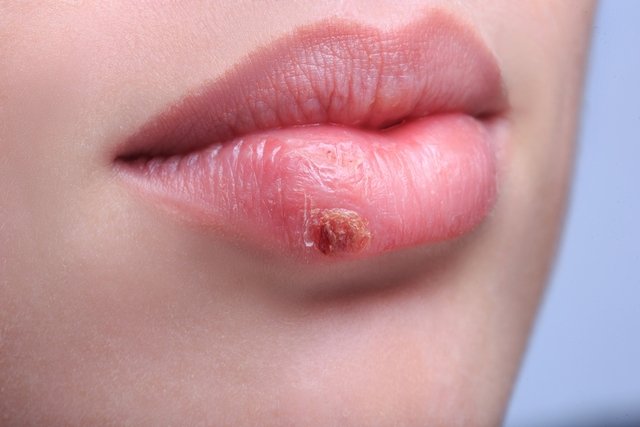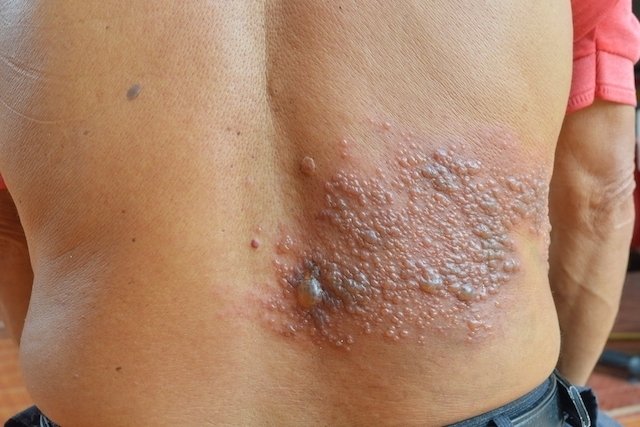Herpes is a highly contagious disease that is caught through direct contact with someone’s herpes sore, kissing, sharing drinks or unprotected intimate contact. Furthermore, in some cases, it may also involve sharing some items of clothing.
Furthermore, contact with an object infected with the virus, such as a glass, cutlery, towels belonging to the infected person, is also highly contagious at the stage when the wound is full of blisters filled with liquid.
Read too: Herpes: what it is, symptoms, types, transmission and treatment
If you suspect herpes, you should consult a dermatologist, gynecologist or urologist so that the diagnosis can be made and treatment indicated, which normally involves the use of antiviral drugs in the form of ointments or tablets.

Depending on the type of herpes, there are specific situations that can transmit the virus:
1. Herpes labial
The cold sore virus can be transmitted in several ways, which include:
- Kiss;
- Share the same glass, cutlery or plate;
- Use the same towel;
- Use the same razor blade.
Herpes can also be transmitted by any other object that has been previously used by the person with herpes and that has not yet been disinfected.
Although it is easier for the herpes virus to be transmitted only when a person has a sore in the mouth, it can also pass even when there are no symptoms, as there are times throughout the year when the virus becomes more easily transmissible, even without causing the appearance of wounds on the lip.
Furthermore, a person with cold sores can also transmit the virus through oral sex, which can cause genital herpes in the other person.
Don’t ignore the signs your body is giving you!
2. Herpes genital
The genital herpes virus is easily transmitted through:
- Direct contact with the wound in the genital region and secretions there;
- Use of objects or clothing that have come into contact with the wound;
- Any type of sexual intercourse without a condom;
- Use the same underwear or towels to clean the intimate area.
Contrary to popular knowledge, genital herpes does not spread through the toilet bowl, sheets or by swimming in a pool with another infected person.
See what symptoms may appear in the case of genital herpes.
3. Shingles

Although it has the same name, shingles is not caused by the herpes virus, but rather by a reactivation of the chickenpox virus. Therefore, the disease cannot be transmitted, and it is only possible to transmit the chickenpox virus. When this happens, the person is most likely to develop chickenpox, not shingles, especially if they have never had chickenpox.
The chickenpox virus, responsible for herpes zoster, is transmitted mainly through contact with the secretions released by herpes zoster sores and, therefore, it is very important that the infected person avoids scratching the lesions, washes their hands frequently, as well as leaving the place always covered.
Understand more details about herpes zoster.
How not to get herpes
The herpes virus is very easy to catch, however, there are some precautions that help reduce the risk of transmission, such as:
- Have protected sex with a condom;
- Avoid kissing other people with visible cold sores;
- Avoid sharing glasses, cutlery or dishes with people who have a visible herpes sore;
- Do not share objects that may have been in contact with herpes sores;
Additionally, washing your hands frequently, especially before eating or touching your face, also helps protect against the transmission of various viruses, such as herpes.
Bibliography
- AMERICAN SEXUAL HEALTH ASSOCIATION. Oral herpes. Available at: <http://www.ashasexualhealth.org/stdsstis/herpes/oral-herpes/>. Accessed on April 22, 2019
- CDC. Genital Herpes – CDC Fact Sheet. Available at: <https://www.cdc.gov/std/herpes/stdfact-herpes.htm>. Accessed on April 22, 2019
- CDC. Shingles (Herpes Zoster). Available at: <https://www.cdc.gov/shingles/about/transmission.html>. Accessed on April 22, 2019
- WEBMD. 10 Ways to Reduce the Risk for Genital Herpes. Available at: <https://www.webmd.com/genital-herpes/reduce-risk#1>. Accessed on April 22, 2019
- PLANNED PARENTHOOD. How is herpes prevented?. Disponível em: <https://www.plannedparenthood.org/learn/stds-hiv-safer-sex/herpes/how-is-herpes-prevented>. Acesso em 22 abr 2019

Sign up for our newsletter and stay up to date with exclusive news
that can transform your routine!
Warning: Undefined array key "title" in /home/storelat/public_html/wp-content/plugins/link-whisper-premium/templates/frontend/related-posts.php on line 12
Warning: Undefined array key "title_tag" in /home/storelat/public_html/wp-content/plugins/link-whisper-premium/templates/frontend/related-posts.php on line 13




